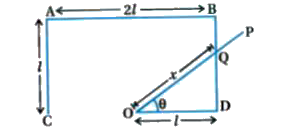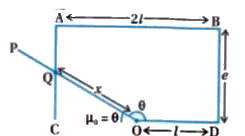InterviewSolution
Saved Bookmarks
| 1. |
ODBAC is a fixed rectangular conductor of negligible resistance (CO is not connected) and OP is a conductor which rotates clockwise with an angular velocity omega as figure. The entire system is in a uniform magnetic field B whose direction is along the normal to the surface of the rectangular conductor ABDC. The conductor OP is in electric contact with ABDC. The rotating conductor has a resistance of lambdaper unit length. Find the current in the rotating conductor, as it rotates by 180^@. |
|
Answer» Solution :(i)Considering situation of OP wire after `t=I/8=pi/(4omega)`  Suppose at this instance wire OP intercept BD at Q. Suppose OQ is x. Area of `DeltaODQ=1/2xxODxxQD` `=1/2xxlxxltantheta` `[because tan theta = (QD)/(OD)=(QD)/l]` `=1/2l^2 tantheta` FLUX linked with `DeltaODQ,` `phi=AB=1/2l^2 tan thetaB=1/2 l^2 Btan(omegat)(because theta = omegat)` Induced emf , `epsilon=(d phi)/(dt)=d/(dt)(1/2 l^2 B tan (omegat))` `=epsilon=1/2 Bl^2 OMEGA^2 sec^2 omegat` Induced current, `I=epsilon/R =epsilon/(lambdax)` (Here only x length of wire OP is inside closed loop , HENCE resistance `R=lambdax`) Now `cos theta = l/x rArr x=l/(cos theta) =l/(cos omegat)` `therefore I=epsilon/(lambdal) cos omegat=1/(lambdal). 1/2 Bl^2 omega sec^2 omegat cos omegat` `therefore I=1/2(Blomega)/(lambdacos omegat)` (ii) For `t=T/8=pi/(4omega)` to `t=(3T)/8=(3pi)/(4omega)`  In this case wire OP intercept AB at Q suppose OQ =x Flux linked with closed loop OQBDO `phi=AB=B(l^2+l^2/(2tantheta))` `phi=Bl^2(1+1/2 cos omegat)(theta = omegat)` Induced emf , `epsilon=-(dphi)/(dt)` `=-d/(dt)Bl^2(1+1/2cot (omegat))` `=-Bl^2xx1/2[-"cosec"^2 (omegat)](omega)` `epsilon=1/2Bl^2omega "cosec"^2 (omegat)` Induced current `I=epsilon/R=epsilon/(lambdax)=(epsilonsinomegat)/(lambdal)` `(sin theta =l/x rArr x=l/(sin omegat))` `I=1/(lambdal)xx1/2Bl^2 omega"cosec"^2 (omegat). sin(omegat)` `I=1/2(Blomega)/(lambda sin (omegat))` (iii) Now `t=(3T)/8=(3omega)/(4pi)` to `t=T/2=pi/omega` Suppose wire PQ intercept AC at Q and OQ =x (see figure)  Flux linked with closed loop OQABDO is , `phi=BA=B(2l^2-l^2/(2tan (omegat)))` Induced emf, `epsilon=(dphi)/(dt)` `=d/(dt)[Bl^2(2-1/(2 tan (omegat)))]` `=(Bl^2)/2 omega "cosec"^2 (omegat)` Induced current , `I=epsilon/R = epsilon/(lambdax)=epsilon/(lambdal)sin(omegat)` `=1/(lambdal) sin (omegat). (Bl^2omega)/2 cos^2 (omegat)` `=1/2(Blomega)/(lambda sin (omegat))` |
|